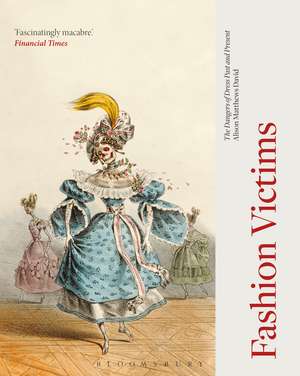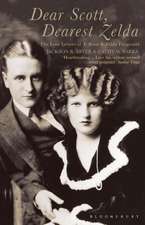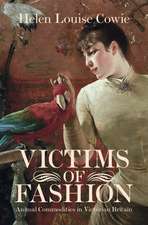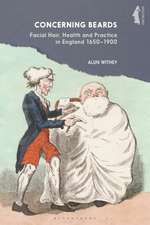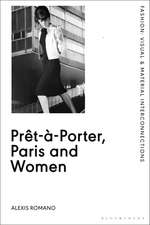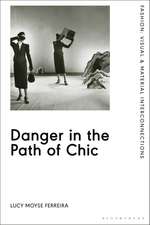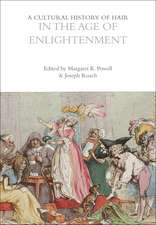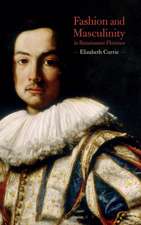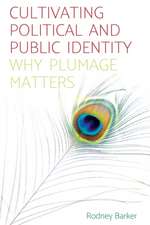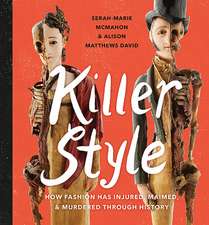Fashion Victims
Autor Alison Matthews-Daviden Limba Engleză Paperback – 13 iul 2017
From insidious murder weapons to blaze-igniting crinolines, clothing has been the cause of death, disease and madness throughout history, by accident and design. Clothing is designed to protect, shield and comfort us, yet lurking amongst seemingly innocuous garments we find hats laced with mercury, frocks laden with arsenic and literally 'drop-dead gorgeous' gowns. Fabulously gory and gruesome, Fashion Victims takes the reader on a fascinating journey through the lethal history of women's, men's and children's dress, in myth and reality. Drawing upon surviving fashion objects and numerous visual and textual sources, encompassing louse-ridden military uniforms, accounts of the fiery deaths of Oscar Wilde's half-sisters and dancer Isadora Duncan's accidental strangulation by her long, fringed scarf; the book explores how garments have tormented those who made and wore them, and harmed animals and the environment in the process. Vividly chronicling evidence from Greek mythology to the present day, Matthews David puts everyday apparel under the microscope and unpicks the dark side of fashion. Lavishly illustrated with over 100 images, Fashion Victims is a remarkable resource for everyone from scholars and students to fashion enthusiasts.
Preț: 126.43 lei
Preț vechi: 207.17 lei
-39% Nou
22.37€ • 26.09$ • 19.64£
Carte disponibilă
Livrare economică 25 decembrie 25 - 08 ianuarie 26
Livrare express 11-17 decembrie pentru 129.34 lei
Specificații
ISBN-10: 1350005088
Pagini: 240
Ilustrații: 129 colour illustrations
Dimensiuni: 220 x 277 x 18 mm
Greutate: 0.95 kg
Ediția:NIP
Editura: BLOOMSBURY ACADEMIC
Colecția Bloomsbury Visual Arts
Locul publicării:London, United Kingdom
Caracteristici
Notă biografică
Alison Matthews David is Associate Professor in the School of Fashion, Ryerson University, Toronto, Canada.
Cuprins
Introduction: Death by Fashion in Fact and Fiction1. Diseased Dress: Germ Warfare2. Toxic Techniques: Mercurial Hats3. Poisonous Pigments: Arsenical Greens4. Dangerous Dyes: A Pretty, Deadly Rainbow5. Entangled and Strangled: Caught in the Machine6. Inflammatory Fabrics: Flaming Tutus and Combustible Crinolines7. Explosive Fakes: Plastic Combs and Artificial SilkConclusion: The Afterlife of Fashion VictimsBibliographyIndex
Recenzii
An innovative take on "killer style" ... Fascinatingly macabre.
Carefully researched and beautifully illustrated.
[A] brilliantly illustrated and fascinating book.
The book's breezy narrative and lavish design make it a delight for any reader ... With its shocking revelations and entertaining stories, all illustrated in glorious Technicolor, Fashion Victims is a history to die for.
Alison Matthews David has brass-tackled the subject [of fashion victims] . [She has] shown in gruesome detail many fashions that did - and still could - hasten their wearers to an untimely death.
Fashion Victims is certainly an eye-opener ... Readers will no doubt ... appreciate the images and historic prints included in this handsome and well-researched book.
Meticulously researched and referenced, filled with interesting historical facts and anecdotes, Dr. Alison Matthews David narrates this dark journey through clothing with authority and precision that is light and joyful to read. Fantastic frock pictures and gruesome medical illustrations along with paintings, photographs and fashion plates help to bring the story alive.
Fashion Victims is a compelling and thought-provoking book with a great selection of illustrations. Matthews David has succeeded in creating an accessible academic text and important historical work, which dress historians will find invaluable.
[A] beautifully illustrated, accessible and highly thoughtful study.
Combining narrative verve with a brilliant selection of pictures, Fashion Victims is both an engaging read and a 'useable history'. Meticulously researched, it wears its academic credentials lightly, and the story it tells is at once entertaining and startling. Fashion history will never seem quite the same again.
No book explores fashion as a seductive pleasure that kills like Alison Matthews David's Fashion Victims. With contaminated cloth, mercury-laden fur and toxic dyestuffs, poisoned fashion silently claims its victims - makers and wearers. This panoramic work outlines the hazardous substances used in fashion, both past and present.
A highly engaging and thought-provoking book. Informative, entertaining and unsettling, Fashion Victims is a history of death by dress for fashionistas and scholars alike. Read it!
In this provocative and beautifully-illustrated volume, Alison Matthews David spans past and present, producers and consumers, Europe and the United States, to explore the many ways that fashionable clothing and accessories harmed and sometimes killed. A fascinating read and essential backdrop to concerns about today's globalized textile and garment production.
Alison Matthews David's Fashion Victims: The Dangers of Dress Past and Present examines fashion's fearful past, when crinolines were a serious fire hazard (Oscar Wilde's half-sisters found out the hard way) and the aniline dye in eyelash and eyebrow tinting was blinding style-savvy users.
Fashion Victims: The Dangers of Dress Past and Present is not only a smartly written, in-depth and deeply interesting book, it is also an important work of historical research and sobering account of some of the very real, very deadly dangers that have lurked - and continue, in certain cases, to reside - in our closets and places of clothing manufacturing alike.
Fashion historian David (Ryerson Univ., Toronto) examines how clothing caused death, disease, and madness during the 19th and early 20th centuries in France and North America, transmitting contagious diseases, emitting chemical toxins, and catching fire. compelling and sometimes disturbing . does make a case for reexamining our fashion consumption in the 21st century and how that consumption hurts the environment and people, especially those in developing countries where most apparel is now produced.
Focusing on the mid-1700s to the 1930s, the book is an astonishing and sometimes gory account of the ways in which clothing has killed, either by accident, by design, or through treacherous manufacturing conditions. This dark history is presented alongside a series of illustrations from the era, which show just how dangerous dressing could be.
In gruesome and fascinating terms, Matthews David focuses on the 18th, 19th, and early 20th centuries, recounting ways people have literally died for fashion, from clothing that harbored germs or caught fire easily to poisonous arsenic in green dyes and mercury in fur hats. The conclusion draws parallels to the dangers of fast fashion, with its sweatshops and toxic industrial manufacturing processes.
David's publication begs that we collectively examine the lengths we will go to for personal style . David probes this idea, noting that fashion has long been a marker of social status as well as moral compass, two things that were taken very seriously in times like the 19th century. Even today this still rings true, as we still make judgments about a person's values based on their clothing choice, and luxury clothing and labels still act as a status signifier to separate us. Though we have moved past the times of arsenic imbued garments and lethal dyes, David also notes the deadly dangers of the creation of fashion of today. Workers in unsafe conditions with little other options but to take jobs working long hours doing the same thing day-in and day-out, with disastrous long-term effects, are not looked over by David.
Laden with colorful pictures, artwork, articles, newspaper clippings, and ads, Fashion Victims puts it all on the table in its artful and intelligent layout . the book is excellent for history enthusiasts and a must-have for anyone with an interest in fashion.
We think of drop dead gorgeous clothes as deadly only for our wallets. But they can kill. And have . From hats laced in mercury to entangled scarves and easily inflammable fabric Matthews-David reveals the darkest side of fashion . Half-terrifying, half-fascinating, Fashion Victims is an eye-opener . beautifully illustrated too.
